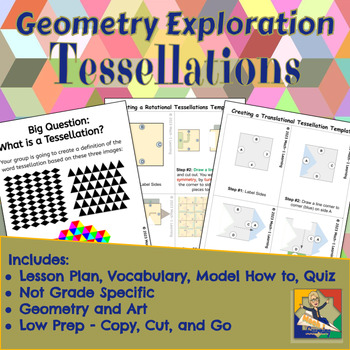Tessellations: Combining Geometry and Art
- PDF
- Easel Assessment
Description
This integrated geometry and art lesson aims to foster a deep understanding of geometric concepts and symmetry through the creation of tessellation art. Bonus: Includes a tree tessellation template that is great for Winter or Spring activities. This geometry lesson is integrated with art to engage even the most math resistant of your students.
By combining mathematical principles with artistic expression, students will explore the beauty of repeated patterns that seamlessly fit together without gaps or overlaps.
In the first session, students work in small groups to develop their definition of tessellation, refining it through visual clues and the exploration of complex images. The whole class then unveils the official definition of tessellation, emphasizing its three key components: a repeated pattern, absence of overlap or gaps, and the potential for infinite continuation on a plane. Geometry vocabulary is introduced, setting the stage for the hands-on activity.
Session #1 (estimated time: 60 minutes)
- Small Group: Students create a definition of “tessellation” by reviewing images
- Whole Class: Introduce vocabulary related to geometry
- Independent: Students create their template for their translational tessellation
During the second session, students create their own translational tessellation templates using provided materials and directions. This engaging art project enhances geometric understanding but also encourages creative expression, making the often-intimidating realm of math accessible and enjoyable for all students.
Session #2 (estimated time: 60 minutes)
- Whole Class: Students review vocabulary related to geometry
- Whole Class: Students examine which polygons make a good base for tessellations
- Independent: Students create their artwork using their template
Optional Included Activities
- Directions on how to make a rotational tessellation
- Quiz related to vocabulary with an answer sheet (Digital Version Available❣️)
- Bonus: Tree Tessellation Pattern great for Winter and Spring Activities
- Ideas for Learning Extensions
Vocabulary covered: tessellation, polygon, equilateral polygon, angle, plane, vertex, adjacent, symmetry, shapes, reflective (flip) symmetry, rotational (turn) symmetry, and translational (slide) symmetry






